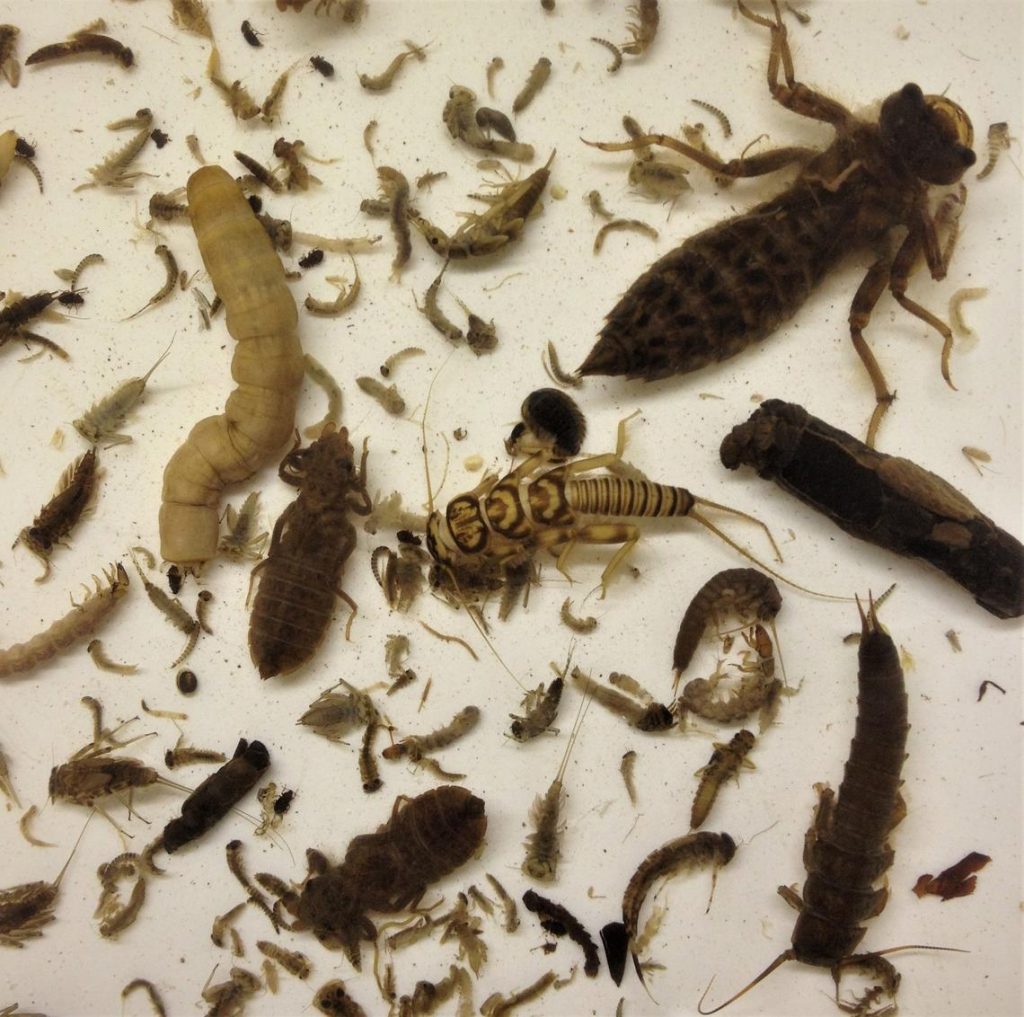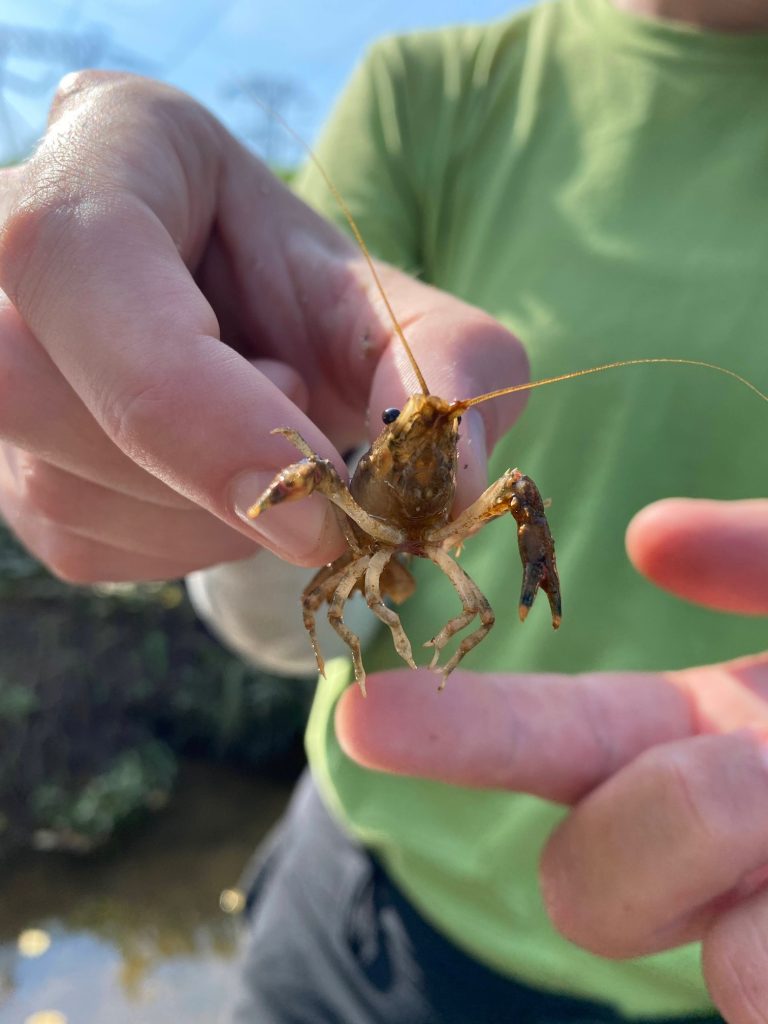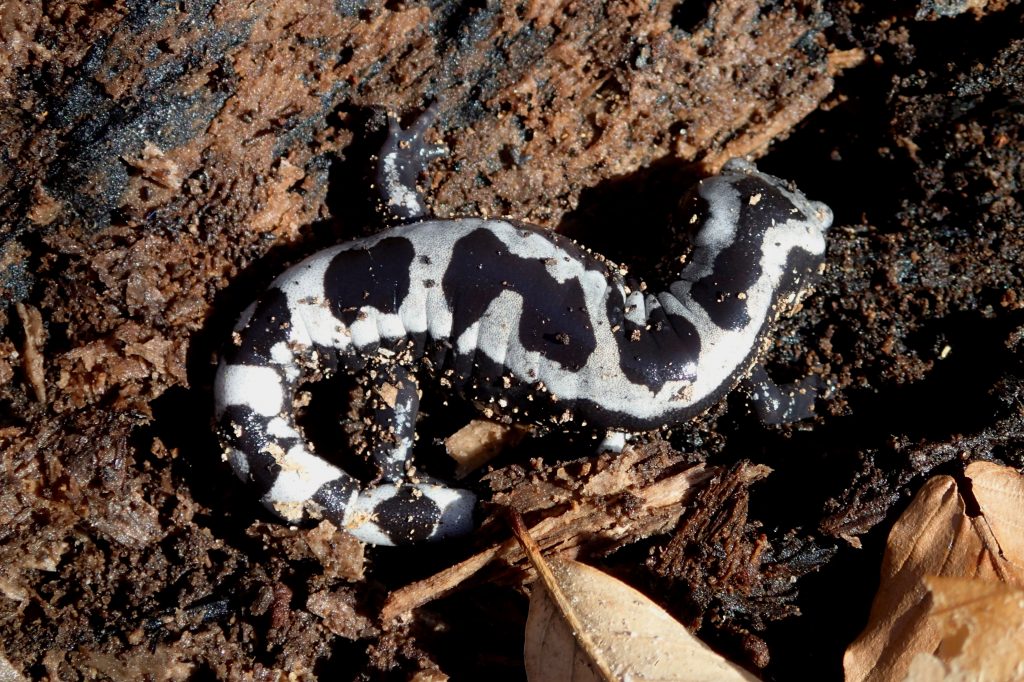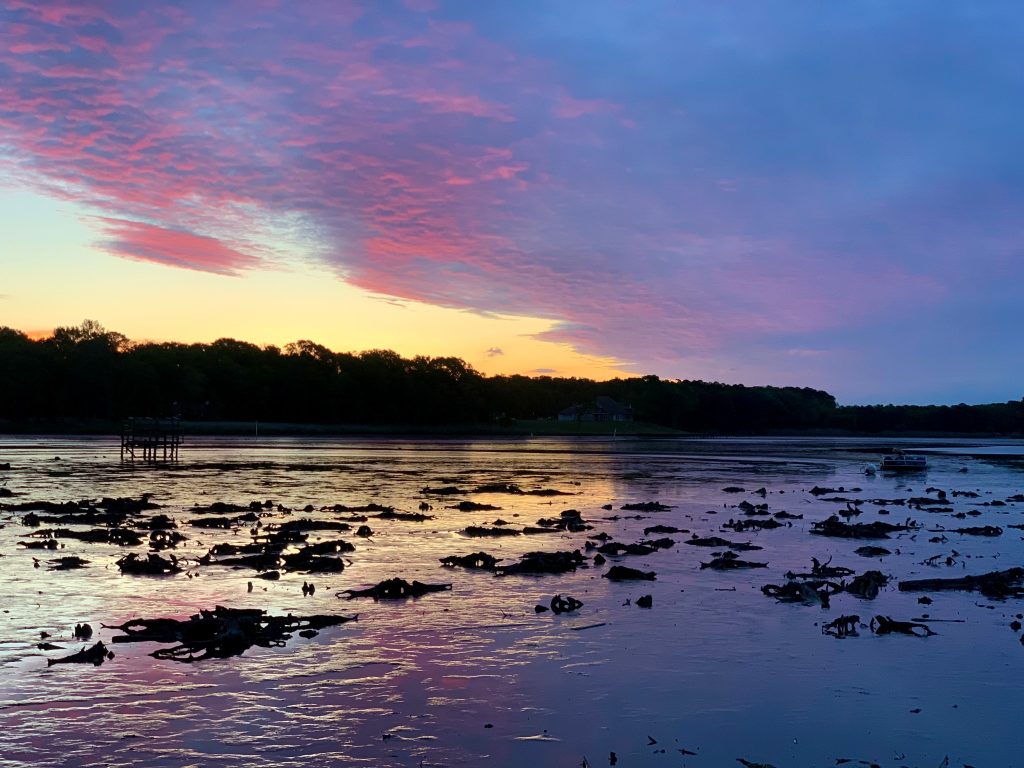
Facebook Twitter Instagram YouTube
Written on: December 8th, 2021 in Wetland Restoration
By Sarah Bouboulis, Partnership for the Delaware Estuary
The Partnership for the Delaware Estuary (PDE) has been interested in living shorelines and shellfish research since the early 2000’s, led by Senior Science Director, Dr. Danielle Kreeger. Since 2004 PDE has installed several living shorelines throughout the Delaware Estuary, primarily using materials such as coconut coir logs, Oyster Castles© and oyster shell bags. During the formative years of PDE’s Delaware Living Shoreline Initiative program (DELSI) and subsequent project monitoring, it became clear that oyster shell bags, in many instances, were one of the best choices for living shorelines based on shellfish recruitment and shoreline stabilization data. However, recycled oyster shell were becoming a hot commodity (i.e. expensive and hard to come by). Subsequently, PDE saw a need for an oyster shell recycling program within the Delaware Estuary.
It took quite a few years to have resources lined up in such a way that both space and funding, for management of the shell, were secure. The stars finally aligned in 2016 when space and funding became available simultaneously in Wilmington, Delaware.
Pre-pandemic, the program was collecting from 9 restaurants in Northern Delaware and one in Dover, Delaware. Between 2016 and 2019, the restaurant collections averaged 1,400 bushels a year (or 70,000lbs). Sadly during 2020 most restaurants closed for an extended period of time and, unfortunately, a few restaurants were forced to close permanently. Since businesses have begun to open back-up, collections have re-started and for 2021 the total collections will near 1,000 bushels.



Currently, collections are only with restaurant partners. Pick-ups are conducted weekly or bi-weekly, depending on the season, and the shell is brought back to the shell management area in Wilmington. Shell is cured in the open between 6-12 months, being turned at least once during that time before it is then, usually, bagged and ready for use on living shoreline or other restoration projects. The curing time is set to make sure the shell has properly cured and there is no risk of introducing disease, pathogens, or other foreign materials back into area waters.

The next step is preparing the shells for transport and/or use on a living shoreline. This typically involves putting the shells into mesh bags. This is the most time and labor intensive portion of the process and it would not get done without the help of countless volunteers. It is also a group activity, needing around 10 volunteers per bagging session. Groups from University of Delaware, Delaware Technical Community College, Wilmington Green Jobs, Bank of America, the Camden Power Corps and many others have all helped with shell bagging. And PDE is so appreciative of their participation!


The fully cured shell goes primarily to living shorelines projects, many put in by PDE. Recycled shell is also sold to restoration partners for other projects such as reef creation and aquaculture research, as well as living shorelines being implemented by others. The main focus of PDE’s oyster shell recycling has always been to support projects within the Delaware Estuary, however, when excess shell exists it has been sold outside the Estuary. You can view a new story map outlining all of PDE’s living shoreline projects, most of which incorporate recycled oyster shell here.
Since inception, over 12,800 bags of shell have been created, which could secure over 4000 feet of shoreline! The shell has gone to support projects in all three states in the Estuary involving a tremendous amount of partners including the Philadelphia Water Department, DNREC, USFWS, The Nature Conservancy, Haskin Shellfish Research Laboratory, and University of Delaware, to name just a few!
In 2022, PDE hopes to expand oyster shell recycling into the city of Philadelphia along with help and support from the Philadelphia Water Department. In such a major metropolitan area, and with a much larger shell management area, the program should be able to collect and cure several times more oyster shell than our current operations.
To learn more about the program, how to volunteer or to purchase shell, you can view our website here or contact Sarah Bouboulis; sbouboulis@delawareestuary.org.
Written on: December 8th, 2021 in Wetland Assessments
By Brittney Flaten, DNREC’s Watershed Management and Assessment Section
Before I started at DNREC, I worked in Maryland conducting stream health assessments. When I joined the Wetland Monitoring and Assessment Program (WMAP) I was excited to learn that the team was working on a new stream assessment protocol. Let’s look at what a stream assessment is, and how stream health relates to the work that our team does in Delaware.
What is a stream assessment?
Stream assessments can be used by governments, nonprofits, or citizen scientists to document stream health in their area. Most states have their own protocol – WMAP is currently working on one for Delaware! Local environmental groups like Nanticoke Watershed Alliance and Delaware Nature Society have their own methods that volunteers use to collect data. While each organization may have a different protocol for assessing stream health, there are generally four kinds of data collected.
Water Quality
When WMAP is assessing stream health, we’re interested in measuring characteristics like water temperature, dissolved oxygen, and pH, which impact what kinds of animals can live there. In the field, we use a handheld water quality meter with sensors that can detect temperature, oxygen, and dissolved ions in the water. We also look for signs of water pollution like discoloration, oily sheens, excessive algae, or unusual smells. There are several organizations in Delaware that collect other kinds of water quality information like the concentration of nitrogen, phosphorus, and total suspended solids. If you’re interested in learning more, you can check out the Delaware Water Quality Portal.
Hydrology
To assess hydrology, we look for evidence that the stream’s shape has been altered by humans. Some examples of alterations include culverts, dams, or walls that straighten the stream. We’re also interested in the stream’s ability to connect with the surrounding floodplain, which we can determine by looking at how incised the stream is. Floodplain connection is particularly important during storm events. When water levels rise, the excess water and debris can spill out onto the floodplain, rather than causing damage to inhabited areas or infrastructure downstream.
Habitat
Before looking for organisms, we assess the quality of habitat in the stream. Potential habitats include submerged aquatic vegetation (SAV), logs and other woody debris, piles of leaves, and root wads from trees. All of these provide a place for organisms like fish, crayfish, and insects to hide from predators and find food. We also look for signs of excess sedimentation in the stream, which can stress fish, invertebrates, and aquatic vegetation. Tall, eroded banks, muddy water, and lots of silt or clay covering the bottom of the stream are all signs that there is too much sediment.
Biology
To find living organisms in streams, we sample habitat like logs and root wads using a D-net, which has very small holes that only let water escape. Most of the organisms we find in our nets are benthic macroinvertebrates like freshwater clams and mussels, snails, mayflies, water beetles, and dragonfly larvae. We use keys and guidebooks to help us identify, sort, and count them in the field. Of course, we also look for fish, salamanders, and frogs! Sometimes we’re lucky and find one in our D-net, or we see them but can’t catch them! In the office, we categorize organisms based on how tolerant they are to environmental stressors like pollution or low dissolved oxygen levels. For example, mayflies, stoneflies, and caddisflies are very sensitive to stressors, but worms and fly larvae are not. If we find many sensitive organisms in our sample, it’s likely the stream is in good condition.


Why are we interested in stream health?
Clean streams provide clean drinking water, good habitat for fish and other organisms, and opportunities for recreation. Also, stream health and wetland health are closely related. Riverine wetlands, for example, depend on water supply from streams that are well-connected to the floodplain. On the other hand, wetlands purify water before it enters streams and rivers by trapping substances like sediments, fertilizers, and pesticides. Both wetlands and streams are important in improving the overall health of our watersheds. If you’re interested in learning more, visit the Division of Watershed Stewardship’s website. If you’re looking to get involved in stream health in your community, there are several opportunities with Nanticoke Watershed Alliance, Delaware Nature Society, and University of Delaware Citizen Monitoring Program.
Written on: December 8th, 2021 in Education and Outreach
By Olivia McDonald, DNREC’s Wetland Monitoring and Assessment Program
Get ready to get down and dirty as we wade into Delaware’s wetland habitats for an interview.
No better way to get to know wetlands than by chatting with one. Today we’re interviewing Delaware’s wetlands. Thanks for taking the time to join us today for a chat!
Of course, I love any opportunity to get the word out there about who I am.
Let’s start in the past. Could you tell us a little about your history? Like how you got to where you are today?
Well, the best way to put it is that it all started a very long time ago. Although some wetlands can form very quickly, many actually take thousands of years to develop. In the case of myself, as tidal and non-tidal habitat, it has been most common through the years for me to form when coastal lowlands flood, when rivers deposit sediment as they reach the ocean, through periodic flooding or high water tables, in isolated or low-lying areas surrounded by dry land, or through other forces of nature – including people! Over time, herbaceous plants, shrubs, and trees with special adaptations take root in my soil. Since about the 1600’s, at the start of colonial settlement in Delaware, I’ve been facing challenges ranging from land loss from development, to the effects of climate change, and that’s just in the past 30 years. Currently, I make up 20% of the land in Delaware, and around 5% of the land in the United States.
What is a day in the life like for a wetland?
Busier than you think! I actually have a lot of responsibilities for others, not just myself. Many species of birds and fish depend on my specialized habitats. Some of Delaware’s most unique species, like the Marbled salamander, call me their home. I also do tons of cleaning, and not like the tidying up kind. I filter toxins and pollutants out of the water through my spongy soil, and absorb carbon dioxide or other greenhouse gases. This helps with making sure that any water entering our streams, rivers, and groundwater systems is clean. I also divert floodwaters to keep them away from people and their property. And let’s face it, Delaware is not very high up off the ground. So negative impacts from large storm events, such as flooding or erosion, would occur more likely if I simply was not around. The easiest way to put it is that my job is to provide, purify, and protect. That’s what I spend my day doing and love it.

What is one strength and one weakness?
A strength? Hmmmm. I’m really good at giving people what they want. And I mean that in an economical and even emotional sense. Here in Delaware, the outdoor enthusiast lifestyle is growing rapidly. Eco-tourism is a major component to the state’s economy, as well as the development industry. State parks, recreational activities, nature centers, they all rely on wetlands in some way. As for the emotional bit, it can be simply put; people rely on wetland ecosystems to make them happy. Whether it is kayaking at Killens Pond State Park, or fishing at the beach, people far and wide are getting outside to experience the great outdoors. And wetlands are gateway to that personal joy.
On the other hand, my weakness has more to do with perception. I’d say the hardest thing I deal with is being misidentified. I’m usually covered with water during the winter and spring months, then my surface is often dry during the summer and fall months. My tidal wetlands, or better known as marshes, tend to get the spotlight. Sometimes that shadow casts over my non-tidal, or freshwater wetlands, that come in all different shapes and sizes. I’ve got flats, depressions, riverine, swamps, and fens. My changing water levels and specialized habitat types can make identifying me as a wetland area very difficult, and that’s tough to deal with.
What is your biggest challenge you face right now?
Policy and implementation. Take my non-tidal wetlands for example. Currently in Delaware, the state only regulates non-tidal wetlands of 400 contiguous acres or more. And my freshwater habitats make up 75% of all the wetlands in Delaware! That’s a large amount of uncertainty when it comes to my protection. When you think about implementation, that’s more along the lines of what can be done to protect me on any size scale. If you can believe it, 80% of my wetlands are actually on private property, which leaves another huge amount of planning to the average citizen. The challenge I’m seeing here isn’t that the public does not care, it’s that they simply don’t know! They’re not sure about incentive programs, people don’t have the scientific background in implementing restoration projects. But that doesn’t mean they can’t. For now, it’s an uphill battle, but one I’m certainly willing to walk.
So what can we do as the general public or homeowners to protect you for future generations to come?
First and foremost, educate yourself. The first step in understanding what to do in the future is how to behave in the present. Leave plants or an un-mowed strip of land between developed areas. Plant native species in your yard and remove the invasive ones. Dispose of trash in proper locations or recycle where appropriate. These baby steps on an individual level can assist me with my job to provide, purify, and protect. If you want to get even more involved in protection, start looking around at what is on your property. I mentioned earlier a challenge I constantly face is being misidentified. There is an amazing mapping resource, The Freshwater Wetland Toolbox, that can assist you with finding wetlands or your property or in your local community. If you find out there’s a wetland on your property, you can use the Guidebook for Public Participation to learn about what you can do to manage my vital land. The information is out there and progress is moving forward for wetlands benefits, you just have to find it.
Well, we certainly learned quite a bit without putting on waterproof boots or hopping in a boat. Thanks again for taking the time to chat with us!
No problem at all. If you’d like to stay up-to-date on how I am doing, my biggest supporters at DNREC’s Wetland Monitoring and Assessment Program are always doing work in my favor. I can’t thank them enough for always building me up when I’m sinking down! I’m sure you’ll see more from me in the near future.

